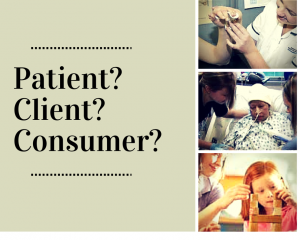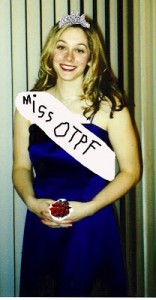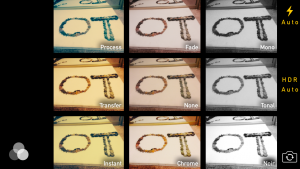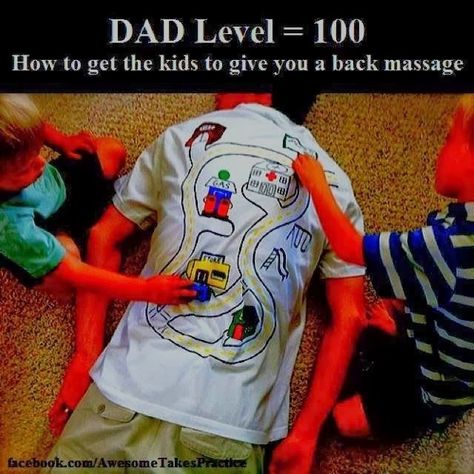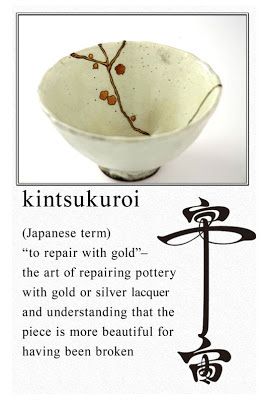Therapists
Controversy: Patient versus Client versus Consumer?
Patient, Client, or Consumer? In occupational therapy and other healthcare fields, there is a semantic controversy over what us therapists/the public should be calling those who utilize occupational therapy services. Depending on the label used, we get a different feel for the relationship between therapist/person.
My friend, a psychologist, told me she likes to use the word “patient” because it came from Latin and means “one who suffers,” and she feels the people who see her are there because they are suffering. Some therapists prefer “client” as they feel “patient” has more of a superior-inferior feel, as well as a “medical model” feel, and many OTs feel we need to be more encompassing. Other therapists prefer “consumer” because it seems to have a more neutral connotation. I’m sure there are plenty of other reasons for the different labels. Some therapists feel very passionately about the “appropriate” label, others don’t really care, others use them interchangeably. I think there may be an even better label out there. Hmm. So I just asked my pediatric therapist friend what she calls the people she sees, and she said with a shrug, “child.” I loved that answer! Maybe that’s the best one of all. 🙂
What do you think? Patient, client, or consumer?
Framework-III for OT Students/Practitioners, Cheatsheet
The newly updated Occupational Therapy Practice Framework: Domain and process, 3rd edition, otherwise known as the Framework-III is an important document provided by the American Occupational Therapy Association, and all therapists and students should be intimately familiar with it. Figuratively. Only figuratively. I have slept with it though. Literally, in OT school, I fell asleep with the first edition more than once. That’s why they called me Miss OTPF. We had a Miss OTPF pageant too, but the opposite of occupation-based in true parody style! Anyway. Moving on. Now that I am back in school for my post-professional clinical doctorate in occupational therapy (OTD), the Framework-III and I are once again sharing a pillow, and I’m putting my crown back on, deserved or not.
The true framework is quite long, so this just gives you a cheatsheet taste of categories/terminology. Here’s a 1- page PDF of this outline of the Framework-III. FrameworkOutline.pdf
Occupational Therapy Practice Framework: Domain and Process, 3rd ed., (abbreviated/referred to as Framework-III)
An official document provided by AOTA, summarizing occupational therapy’s unique approach to healthcare. Our domain focuses on “achieving health, well-being, and participation in life through engagement in occupation,” through a vision of “occupation based, client centered, contextual, and evidence based” care.
OTs must evaluate a client holistically and deductively with an “occupational profile”, using below categories as guidelines, before determining intervention approach.
Clients can refer to persons, groups, and populations [newly expanded definition]
Occupations (meaningful life activities that clients engage in)
- Activities of Daily Living (ADL) – (personal hygiene, bathing, sexual activity, etc.)
- Instrumental Activities of Daily Living (IADL) (care of others, community mobility, financial management, shopping, safety, etc.)
- Rest and Sleep, Education, Work, Play, Leisure, and Social Participation
Client Factors (reside within client and influence client’s performance in occupations)
- Body Functions, Body Structures, Values, beliefs, and spirituality
Performance Skills (observable actions with a functional purpose)
- Motor skills (observed physical interactions, i.e. reaching, bending, manipulating)
- Process skills (observed “executive functioning” during a task, i.e. initiating, sequencing, gathering, problem-solving)
- Social interaction skills (observed during social interactions, i.e. transitions, gesticulations)
Performance patterns (behaviors related to activities of daily life)
- Habits, Routines, Rituals, Roles
Context (environmental conditions that may affect client’s performance)
- Cultural, personal, physical, social, temporal, virtual
*Please see reference for comprehensive details in each area. Use this brief handout at your own risk!
Example of citation in-text: We used the Occupational Therapy Practice Framework: Domain and Process, 3rd ed., ([Framework-III], AOTA, 2014) for our project. The Framework-III (AOTA, 2014) is awesome.
Reference: American Occupational Therapy Association. (2014). Occupational therapy practice framework: Domain and process (3rd ed.). American Journal of Occupational Therapy, 68(Suppl. 1), S1-S48.
Hyperchange Curriculum for Occupational Therapy Students
In an Utopian OT world, there would be a weekly 3-hour course that spanned the duration of an occupational therapy student’s career in their master or doctorate OT program. It would primarily consist of guest speakers from other disciplines or expert OTs. Many would require real-world assignments. The curriculum would be extraordinarily interdisciplinary, cutting edge, relevant, and innovative, with a focus on what OT Jim Hinojosa addressed as “hyperchange” in his 2007 Slagle lecture. He discusses how OT student curriculums need to evolve so they better address “how” to learn, rather than “what”, with emphasis on flexible thinking, problem-solving, creativity, efficiency, and a much more interdisciplinary focus. Students would be equipped with cognitive tools to navigate the future, and learn how to access the information they need when in a constantly changing environment. He notes today’s students have spent their entire lives in a hyperchange environment, and are best suited to the challenges we face ahead in this area. Here are some of my (idealistic) class ideas.
- Legalities and Liabilities of Innovative Practice (lawyer)
- Fundraising, Grant Writing, Finding Sponsors/Volunteers (expert)
- Entrepreneurialism, Marketing/Branding in Changing Healthcare world (marketer, designer)
- Keeping Occupations Intact in Face of Productivity/Budget Challenges (OT)
- Awareness of Eastern Medicine/Naturopaths/Alternative Healing (healer)
- Interdisciplinary Relations: Collaboration and Creation (multi-disciplinary panels)
- Healing Touch and Energetic/Touch Modalities (practitioner)
- Inventions/Product Design, How To (experienced inventor)
- Perspectives of client and therapists in mental Health OT (client, mental health OT)
- Perspectives of client and therapists in OT Emerging Practice Areas (panel of OTs and clients of differing areas)
- Flexible-Thinking and Problem-Solving (cognitive psych? hmm)
- Perspectives of OT from Other Disciplines (panel)
- Creative Use of Thrift Store/Dollar Store Materials
- Creating Something out of Nothing: Ninja OT with limited access to materials
- Psychology of Persuasion, Motivation, Hope (specialized psychologist)
- Psychology of Trauma/Grief: Reflective Listening and Clinical Communication Skills (specialized psychologist)
- Psychology of Illusions and Conmen: Skillfully using psychological techniques of distraction, expectation, and perspectives to approach challenging OT sessions (guest performance pickpocketer or similar – see bottom for details – not to be used in a manipulative way but rather helpful).
- Lots more ideas!
I know my program (I graduated in 2009) addressed some of these, and I hope and imagine many current programs are addressing this via prerequisites or within the program itself. I’d love to hear what other OTs would like addressed, or what educators are already starting to address. I’m currently in a post-professional OTD program, so I’m thinking a lot about education!
——–
Bonus: I highly recommend you look at the youtube video and article on the following two real-life characters: Apollo Robbins is a famed (performance) pickpocket who uses the victim’s expectations and distraction against him: http://www.newyorker.com/magazine/2013/01/07/a-pickpockets-tale for the article
This 6-minute video amazed me – he was able to pickpocket the victim even though the victim KNEW Apollo was about to try, and when you watch it assuming you will be able to tell, you can’t. Shocking.
Frank Abagnale was a conman made famous by the movie Catch Me if you Can, although I prefer his autobiography. http://en.wikipedia.org/wiki/Catch_Me_If_You_Can. He was able to successfully impersonate a pilot and doctor and other highly skilled professions, as well as start a new type of check forgery, by the time he was 19. He did a stint in jail, but ultimately ended up working for the FBI in their check fraud department, because he knew better than any non-criminal how to do it! He also used distractions, expectations, perspectives of other, and illusion, as his methods for success.
Playful Pediatric Car Activities Using Road Clothes!
Found this silly picture with the dad wearing a road t-shirt and getting a “car massage” by his children. If you made a child some road pajamas (long-sleeved white shirt and pants and then drawn on with fabric Sharpies or the equivalent), you could do some great occupational therapy work.
Because this does involve “on-body” play, remember to be extremely careful about liability and consider only using this activity when parent is present, so that you can role model how to play at home, and ensure child is comfortable and able to express preferences.
Possible Activities:
PROPRIOCEPTION/TACTILE: Use cars of varying weights for lighter versus heavier touch as you narrate your path (…now we’re cruising along Right Leg Lane, looking for ducks…”) Super light touch: use your two fingers to “walk” as a pedestrian on the sidewalk Heavy touch: Use a heavy beanbag as a bull-dozer and “roll” it along its path
TACTILE: Make the path long and straight down both arms and both legs – if a child doesn’t normally like to put on long sleeves/pants, maybe he would if the car otherwise has to come to a screeching halt so soon on the journey.
STRENGTH: Make path circular around the legs and arms – make child lift up arms/legs for car to travel underneath “ooh your leg is soo heavy, my car is stuck, help!”
RANGE OF MOTION: The car can go down to the hand and and decide it wants to go to the other hand by having child raise both arms up 90 degrees and meeting at midline; the car may need other types of bridges from foot to hand and avoid the “body of water”
DIRECTIONS/ORIENTATION: Have child direct car or vice versa to go south/north/left/right/start at Right Arm Avenue etc
GRADATION OF MOVEMENTS: Have child practice on another child, or on your own long-sleeved shirt (or use washable marker on your arm only), of slow/fast/slower/faster
TURN-TAKING: Switch the car back and forth between the two children or you and child, potentially making a bridge, etc
BALANCE: Consider having the child stand up while the car drives!
More occupational therapy related pins here:
https://www.pinterest.com/funkist/ot-ideas
Magnetic Dry Erase Slant Boards
I really like their magnetic dry erase slant boards for children/adults who benefit from the slant, often due to visual or physical issues – the boards are thin and easy and awesome. I used it all the time, and am buying a new one as I had to give up my former one! They are currently $30 or cheaper if you buy more than 1, but they are going up to $33 starting January 1st.
I wanted to do a good review with lots of pictures and all, but sorry, for now, click on the link, see what you think. It’s straight forward. 🙂 So that you can get one as Christmas presents or before the new pricing goes into effect. I just wish the shipping were cheaper. They are in San Diego though so I am going to see if I can pick mine up.
Enjoy!
Developmentally enriching guide for toys and gifts, recommended by occupational therapists
The following occupational therapists (OT) have posted gift and toy guides that can help you navigate the overwhelming holiday decisions. These are all gifts that are developmentally appropriate and enriching while still being fun. Since OTs are writing them, many of the toys can be geared at children with special needs or varying levels of age/function. Enjoy!
Colleen, OT, at Sugar Aunts, blogged about toys and gifts to help with scissor skills and improving pencil grasps.
http://www.sugaraunts.com/2014/11/toys-to-help-with-scissors-skills-gift.html
http://www.sugaraunts.com/2013/11/gift-guide-toys-to-improve-pencil-grasp.html
Mama OT blogged about toys to help pencil grasp without using a pencil –
http://mamaot.com/2014/11/23/toys-and-games-to-help-kids-pencil-grasp-without-using-a-pencil/
Mama OT also blogged a PRINTABLE list of "Ultimate List of Gifts for Sensory Seekers"
http://mamaot.com/wp-content/uploads/2014/11/PRINTABLE-The-Ultimate-List-of-Gifts-for-Sensory-Seekers.pdf
Her original blog post about it was here.
http://mamaot.com/2013/11/29/ultimate-gift-list-for-sensory-seekers/
Meghan of Mac&Toys posted a MASSIVE holiday toy guide list, Wow!
http://macandtoys.blogspot.com/2014/11/2014-holiday-gift-guide.html
Also, many of us (or okay, at least me) have OT Wish Lists on Amazon, where you might get some ideas. I think mine is under Karen Dobyns…a lot of Melissa & Doug at top, many of which I haven’t tried out yet, but if you scroll down, diverse options below and most of them I have tried.
OT lifehack: Great adaptive doorstop
Most doorstops require bending over, which can be a fall or injury risk. Using the equivalent of a stable fire poker as a doorstop allows you to move the doorstop more easily.
Handmade creative clay pencil grips
To make a creative pencil grip, take the ink part out of a pen, roll it into a polymer oven-bake clay and bake it, following directions you can find online for safety [using appropriate clay, not burning your house down or experiencing toxic fumes by baking it too long, etc]. Here’s a tutorial. Here’s another. Those tutorials show a more covered pen, but I think the grip is better off being wound around the pen like in my pictures below. At least the tutorials give you the basics. I haven’t tried it myself. Use your own judgment as to whether it’s a safe and appropriate activity and method.
Occupational Therapists and Kintsukuroi: Repairing with Gold.
As occupational therapists, we often work with those who feel broken. Sometimes I think applying or receiving the lacquer of repair – and seeing the beauty in it – helps us restore our souls.


